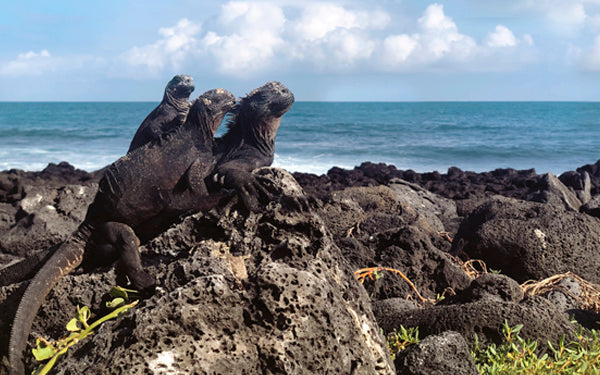 Article 1/2
Article 1/2 Our Marketing Manager went to the remote Ecuadorian archipelago, full of endemic species all more surprising than the others!
This year, I had the great opportunity to visit a place that fascinates me since I was a child. Mysterious, wild, iconic, the Galapagos Islands are a paradise for the animal lover I am!
I had the chance to visit three islands: Santa Cruz, Isabela and San Cristóbal in the two weeks I spent there by traveling by boat and by plane.

A LAND OF REPTILES

When the young naturalist Charles Darwin visited the Galapagos Islands in 1835, he discovered species found nowhere else on Earth.
In addition to the famous finches that inspired his theory on the evolution of species, he observed a great variety of giant tortoises. Each one has physical characteristics peculiar to its respective environment. For example, the tortoise above has a domed shell, suitable for an environment where vegetation is abundant and accessible. The tortoise below has a saddle shaped shell, rather suitable for a diet located at height. This shape has inspired the name of the archipelago because of this singular form.
I have to admit that they are very impressive in real life. I could never have imagined that they were so imposing!

I have often seen terrestrial iguanas during my travels, but marine iguanas can only be found on the Galapagos Islands! These nice prehistoric reptiles are literally everywhere! Their ancestors, that arrived from the mainland a long time ago, had to adapt because of the lack of food, which led them to feed on the seaweed that grows in the rich and salty waters.
THE SEA "DOGS"
The waters surrounding the islands are relatively cold and are home to a diverse fauna, thanks to the Humboldt Current, which is full of nutrients that it transports from Antarctica. This marine wealth allows many species to proliferate. Among them, let's mention the famous hammerhead sharks and tiger sharks. However, the undisputed masters of the shallow waters are, without a doubt, these adorable Galapagos sea lions! During the day, it is possible to observe an impressive number of these basking in the sun! If you have the opportunity to dive with them, you will undoubtedly be impressed by their agility and playful spirit!

COHABITATION IN ALL THIS?

Before I landed, I confess that I was curious to know how the population of the habited islands coexisted with this omnipresent fauna. I was very pleased to see that Ecuadorians seem particularly proud of their unique wildlife! They protect and cherish it with exemplary respect!
At the port of Puerto Ayora, fishermen raise their nets of the surrounded by sea lions, pelicans, frigates, herons and so on! The cohabitation is also to offer them the scrap of fish, to the apparent pleasure of these greedy stomachs.






